-
32 results in Exploration of BioMat-XSort byLatest
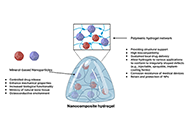 Mineral nanoparticles and nanocomposite hydrogels with osteoinductive properties for bone regenerationOpen AccessReviewMineral nanoparticles and osteoinductive biomaterials are essential in advancing bone regeneration by addressing skeletal conditions and injuries that compromise structural integrity and functionali [...] Read more.Cho-E Choi, Arghya PaulPublished: March 17, 2025 Explor BioMat-X. 2025;2:101332
Mineral nanoparticles and nanocomposite hydrogels with osteoinductive properties for bone regenerationOpen AccessReviewMineral nanoparticles and osteoinductive biomaterials are essential in advancing bone regeneration by addressing skeletal conditions and injuries that compromise structural integrity and functionali [...] Read more.Cho-E Choi, Arghya PaulPublished: March 17, 2025 Explor BioMat-X. 2025;2:101332
DOI: https://doi.org/10.37349/ebmx.2025.101332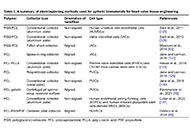 Electrospun scaffolds for heart valve tissue engineeringOpen AccessReviewA potential solution for prosthetic heart valves is tissue-engineered heart valves. Tissue-engineered heart valves (TEHVs) are designed to replicate the complex properties found in natural tissues, [...] Read more.Betül Gürbüz ... Erkan Türker BaranPublished: February 27, 2025 Explor BioMat-X. 2025;2:101331
Electrospun scaffolds for heart valve tissue engineeringOpen AccessReviewA potential solution for prosthetic heart valves is tissue-engineered heart valves. Tissue-engineered heart valves (TEHVs) are designed to replicate the complex properties found in natural tissues, [...] Read more.Betül Gürbüz ... Erkan Türker BaranPublished: February 27, 2025 Explor BioMat-X. 2025;2:101331
DOI: https://doi.org/10.37349/ebmx.2025.101331
This article belongs to the special issue Trends in Biomaterials Research for Cardiovascular Applications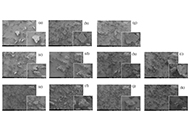 Preparation and characterization of stearyl glycyrrhetinate/cyclodextrin complex using co-grindingOpen AccessOriginal ArticleAim: In this study, the physicochemical properties of stearyl glycyrrhetinate/β-cyclodextrin (SG/βCD) and SG/γCD complexes were characterized, and the complexes were prepared using the co-milling [...] Read more.Momoko Ebisawa ... Yutaka InouePublished: February 26, 2025 Explor BioMat-X. 2025;2:101330
Preparation and characterization of stearyl glycyrrhetinate/cyclodextrin complex using co-grindingOpen AccessOriginal ArticleAim: In this study, the physicochemical properties of stearyl glycyrrhetinate/β-cyclodextrin (SG/βCD) and SG/γCD complexes were characterized, and the complexes were prepared using the co-milling [...] Read more.Momoko Ebisawa ... Yutaka InouePublished: February 26, 2025 Explor BioMat-X. 2025;2:101330
DOI: https://doi.org/10.37349/ebmx.2025.101330
This article belongs to the special issue Nature-Based Biomaterials for Biomedical Applications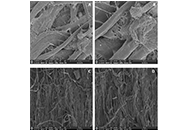 Antifungal effect against wilting disease factor Verticillium dahliae Kleb. by green synthesized silver nanoparticlesOpen AccessOriginal ArticleAim: This study aimed to synthesize, characterize, and evaluate the antifungal efficacy of green-synthesized silver nanoparticles (AgNPs) against Verticillium dahliae Kleb., a soil-borne fungal p [...] Read more.Alp Cokislerel ... Lale Yildiz AktasPublished: February 18, 2025 Explor BioMat-X. 2025;2:101329
Antifungal effect against wilting disease factor Verticillium dahliae Kleb. by green synthesized silver nanoparticlesOpen AccessOriginal ArticleAim: This study aimed to synthesize, characterize, and evaluate the antifungal efficacy of green-synthesized silver nanoparticles (AgNPs) against Verticillium dahliae Kleb., a soil-borne fungal p [...] Read more.Alp Cokislerel ... Lale Yildiz AktasPublished: February 18, 2025 Explor BioMat-X. 2025;2:101329
DOI: https://doi.org/10.37349/ebmx.2025.101329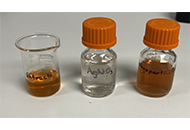 Silver nanoparticles biosynthesized from Stenocereus queretaroensis with antiproliferative activityOpen AccessOriginal ArticleAim: This work aimed to evaluate the antiproliferative activity of silver nanoparticles (AgNPs) biosynthesized with aqueous extract of Stenocereus queretaroensis peel (SAgNPs) in pancreatic ducta [...] Read more.Ariadna Abigail Villarreal-Amézquita ... Eduardo Padilla-CamberosPublished: February 16, 2025 Explor BioMat-X. 2025;2:101328
Silver nanoparticles biosynthesized from Stenocereus queretaroensis with antiproliferative activityOpen AccessOriginal ArticleAim: This work aimed to evaluate the antiproliferative activity of silver nanoparticles (AgNPs) biosynthesized with aqueous extract of Stenocereus queretaroensis peel (SAgNPs) in pancreatic ducta [...] Read more.Ariadna Abigail Villarreal-Amézquita ... Eduardo Padilla-CamberosPublished: February 16, 2025 Explor BioMat-X. 2025;2:101328
DOI: https://doi.org/10.37349/ebmx.2025.101328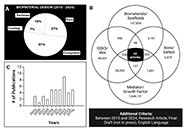 Advances in bone tissue engineering using biomaterial based scaffolds, purine crosslinking and Wnt signalingOpen AccessReviewThe design of effective treatments for critical size bone defects, which result from various conditions such as trauma, infection, injury, or tumor resection, presents a significant challenge in cli [...] Read more.Celine J. Agnes ... Maryam TabrizianPublished: February 14, 2025 Explor BioMat-X. 2025;2:101327
Advances in bone tissue engineering using biomaterial based scaffolds, purine crosslinking and Wnt signalingOpen AccessReviewThe design of effective treatments for critical size bone defects, which result from various conditions such as trauma, infection, injury, or tumor resection, presents a significant challenge in cli [...] Read more.Celine J. Agnes ... Maryam TabrizianPublished: February 14, 2025 Explor BioMat-X. 2025;2:101327
DOI: https://doi.org/10.37349/ebmx.2025.101327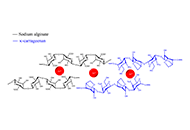 Sodium alginate/κ-carrageenan films for mupirocin dermal deliveryOpen AccessOriginal ArticleAim: The chronicity of injuries is also a public health problem, and it is necessary to develop and apply new materials to promote more satisfactory results in the wound healing. Thus, this study [...] Read more.Tamara Rodrigues de Sousa ... Nelson Luis Gonçalves Dias de SouzaPublished: January 14, 2025 Explor BioMat-X. 2025;2:101326
Sodium alginate/κ-carrageenan films for mupirocin dermal deliveryOpen AccessOriginal ArticleAim: The chronicity of injuries is also a public health problem, and it is necessary to develop and apply new materials to promote more satisfactory results in the wound healing. Thus, this study [...] Read more.Tamara Rodrigues de Sousa ... Nelson Luis Gonçalves Dias de SouzaPublished: January 14, 2025 Explor BioMat-X. 2025;2:101326
DOI: https://doi.org/10.37349/ebmx.2025.101326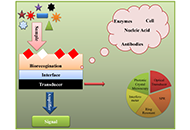 Photonic silver iodide nanostructures for optical biosensorsOpen AccessReviewSilver iodide (AgI) nanostructures have been considered as promising candidates for optical biosensors owing to their optical characteristics of optical properties, including tunable surface plasmon [...] Read more.Humaira Aslam ... Misbah Ullah KhanPublished: December 13, 2024 Explor BioMat-X. 2024;1:366–379
Photonic silver iodide nanostructures for optical biosensorsOpen AccessReviewSilver iodide (AgI) nanostructures have been considered as promising candidates for optical biosensors owing to their optical characteristics of optical properties, including tunable surface plasmon [...] Read more.Humaira Aslam ... Misbah Ullah KhanPublished: December 13, 2024 Explor BioMat-X. 2024;1:366–379
DOI: https://doi.org/10.37349/ebmx.2024.00025
This article belongs to the special issue Plasmonic Nanostructures for Designing Optical Biosensors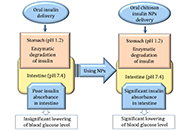 Nanomaterials in the treatment of degenerative intellectual and developmental disabilitiesOpen AccessReviewNanoparticles (NPs) are at the forefront as they are providing unprecedented solutions to obstacles and issues in treating neurodegenerative diseases. Due to their size, surface characteristics, and [...] Read more.Humaira Aslam ... Misbah Ullah KhanPublished: December 13, 2024 Explor BioMat-X. 2024;1:353–365
Nanomaterials in the treatment of degenerative intellectual and developmental disabilitiesOpen AccessReviewNanoparticles (NPs) are at the forefront as they are providing unprecedented solutions to obstacles and issues in treating neurodegenerative diseases. Due to their size, surface characteristics, and [...] Read more.Humaira Aslam ... Misbah Ullah KhanPublished: December 13, 2024 Explor BioMat-X. 2024;1:353–365
DOI: https://doi.org/10.37349/ebmx.2024.00024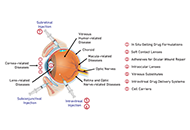 Advancements in hydrogel technology for ocular drug deliveryOpen AccessReviewHydrogel-based drug delivery systems (DDS) offer promising alternatives for treating ocular diseases by overcoming the limitations of traditional therapies, such as low bioavailability, frequent adm [...] Read more.Doanh Truong ... Simon D. TranPublished: December 12, 2024 Explor BioMat-X. 2024;1:331–352
Advancements in hydrogel technology for ocular drug deliveryOpen AccessReviewHydrogel-based drug delivery systems (DDS) offer promising alternatives for treating ocular diseases by overcoming the limitations of traditional therapies, such as low bioavailability, frequent adm [...] Read more.Doanh Truong ... Simon D. TranPublished: December 12, 2024 Explor BioMat-X. 2024;1:331–352
DOI: https://doi.org/10.37349/ebmx.2024.00023
This article belongs to the special issue Bioprinted Hydrogels for Engineering Tissues and Organs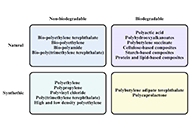 A review of biopolymer innovations in oculoplastic surgery: reconstruction of eyelid, lacrimal, and orbital structuresOpen AccessReviewThe fusion of biomaterial science with clinical practice in oculoplastic and orbital surgery, particularly in the reconstruction of the posterior lamella of the eyelid, the lacrimal system, orbital [...] Read more.Merve Kulbay ... Patrick DaiglePublished: November 28, 2024 Explor BioMat-X. 2024;1:300–330
A review of biopolymer innovations in oculoplastic surgery: reconstruction of eyelid, lacrimal, and orbital structuresOpen AccessReviewThe fusion of biomaterial science with clinical practice in oculoplastic and orbital surgery, particularly in the reconstruction of the posterior lamella of the eyelid, the lacrimal system, orbital [...] Read more.Merve Kulbay ... Patrick DaiglePublished: November 28, 2024 Explor BioMat-X. 2024;1:300–330
DOI: https://doi.org/10.37349/ebmx.2024.00022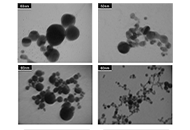 Spectrum reconstruction of experimentally produced nano-colloids using Mie theoryOpen AccessOriginal ArticleAim: Synthesis of plasmonic nanoparticles, characterization, size detection by modeling. Methods: Colloidal plasmonic gold and silver nanoparticles were prepared by laser ablation with a 1, [...] Read more.Hamid Nadjari, Hadi MovahedinejadPublished: October 22, 2024 Explor BioMat-X. 2024;1:289–299
Spectrum reconstruction of experimentally produced nano-colloids using Mie theoryOpen AccessOriginal ArticleAim: Synthesis of plasmonic nanoparticles, characterization, size detection by modeling. Methods: Colloidal plasmonic gold and silver nanoparticles were prepared by laser ablation with a 1, [...] Read more.Hamid Nadjari, Hadi MovahedinejadPublished: October 22, 2024 Explor BioMat-X. 2024;1:289–299
DOI: https://doi.org/10.37349/ebmx.2024.00021
This article belongs to the special issue Plasmonic Nanostructures for Designing Optical Biosensors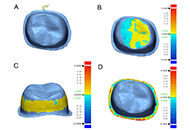 Digital analysis of internal fit variation of additively manufactured crown patternsOpen AccessOriginal ArticleAim: The purpose of this study was to digitally quantify the consistency and variation of printed resin crown patterns produced by different 3D printers, aiming to evaluate their clinical relevan [...] Read more.Wendy A. Clark ... Ingeborg J. De KokPublished: October 14, 2024 Explor BioMat-X. 2024;1:280–288
Digital analysis of internal fit variation of additively manufactured crown patternsOpen AccessOriginal ArticleAim: The purpose of this study was to digitally quantify the consistency and variation of printed resin crown patterns produced by different 3D printers, aiming to evaluate their clinical relevan [...] Read more.Wendy A. Clark ... Ingeborg J. De KokPublished: October 14, 2024 Explor BioMat-X. 2024;1:280–288
DOI: https://doi.org/10.37349/ebmx.2024.00020
This article belongs to the special issue Innovations in Biomaterials for Dentistry and Oral Surgery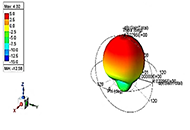 3D printed hernia mesh implant: a conformability studyOpen AccessOriginal ArticleAim: This study aims to explore the sensing capabilities of polyvinylidene fluoride-hydroxyapatite-chitosan (PVDF-HAP-CS) composite-based hernia mesh implants (of conformal/planar design), follow [...] Read more.Abhishek Barwar ... J. Paulo DavimPublished: September 30, 2024 Explor BioMat-X. 2024;1:266–279
3D printed hernia mesh implant: a conformability studyOpen AccessOriginal ArticleAim: This study aims to explore the sensing capabilities of polyvinylidene fluoride-hydroxyapatite-chitosan (PVDF-HAP-CS) composite-based hernia mesh implants (of conformal/planar design), follow [...] Read more.Abhishek Barwar ... J. Paulo DavimPublished: September 30, 2024 Explor BioMat-X. 2024;1:266–279
DOI: https://doi.org/10.37349/ebmx.2024.00019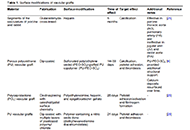 Advancements in surface modification strategies of vascular grafts to improve biocompatibility and tissue integrationOpen AccessReviewImproving the performance of blood-contacting medical implants is a global health necessity aimed at reducing mortality and morbidity in patients with cardiovascular diseases. Surface modification o [...] Read more.Noor Abu Jarad ... Tohid F. DidarPublished: September 13, 2024 Explor BioMat-X. 2024;1:241–265
Advancements in surface modification strategies of vascular grafts to improve biocompatibility and tissue integrationOpen AccessReviewImproving the performance of blood-contacting medical implants is a global health necessity aimed at reducing mortality and morbidity in patients with cardiovascular diseases. Surface modification o [...] Read more.Noor Abu Jarad ... Tohid F. DidarPublished: September 13, 2024 Explor BioMat-X. 2024;1:241–265
DOI: https://doi.org/10.37349/ebmx.2024.00018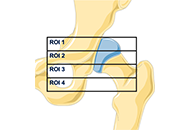 Stress-shielding in aseptic loosening on the 3D printed acetabular cup in hip arthroplasty: review articleOpen AccessReviewThe increasing number of prosthetic hip replacement surgeries and their growing indication have led to a growing interest in understanding the factors that influence their long-term success. Total h [...] Read more.Antonio Ziranu ... Greta Tanzi GermaniPublished: August 31, 2024 Explor BioMat-X. 2024;1:231–240
Stress-shielding in aseptic loosening on the 3D printed acetabular cup in hip arthroplasty: review articleOpen AccessReviewThe increasing number of prosthetic hip replacement surgeries and their growing indication have led to a growing interest in understanding the factors that influence their long-term success. Total h [...] Read more.Antonio Ziranu ... Greta Tanzi GermaniPublished: August 31, 2024 Explor BioMat-X. 2024;1:231–240
DOI: https://doi.org/10.37349/ebmx.2024.00017
This article belongs to the special issue Metal 3D Printing of Biometals for Prostheses and Implants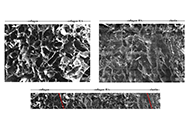 A tri-layer tissue engineering heart valve scaffold based on atelocollagen, hyaluronic acid, and elastinOpen AccessOriginal ArticleAim: This study aims to fabricate and characterise a novel tri-layer scaffold based on type I atelocollagen, hyaluronic acid (HA), and a novel fibrillar elastin gel, mimicking the native heart va [...] Read more.Zhaoying Ma ... Jan T. CzernuszkaPublished: August 29, 2024 Explor BioMat-X. 2024;1:215–230
A tri-layer tissue engineering heart valve scaffold based on atelocollagen, hyaluronic acid, and elastinOpen AccessOriginal ArticleAim: This study aims to fabricate and characterise a novel tri-layer scaffold based on type I atelocollagen, hyaluronic acid (HA), and a novel fibrillar elastin gel, mimicking the native heart va [...] Read more.Zhaoying Ma ... Jan T. CzernuszkaPublished: August 29, 2024 Explor BioMat-X. 2024;1:215–230
DOI: https://doi.org/10.37349/ebmx.2024.00016
This article belongs to the special issue Bioinspired Material for Regenerative Medicine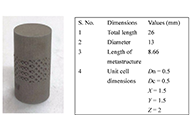 On 17-4PH stainless steel dental implant for premolar 4 in canine under compressive loading: effect of solid and octet metastructureOpen AccessOriginal ArticleAim: The study aims to analyze the canine’s implant behaviour under compressive loading [to be installed in a maxilla at a premolar 4 (PM4) location]. After simulation of various mechanical pro [...] Read more.Bharat Kalia ... Gurwinder SinghPublished: August 23, 2024 Explor BioMat-X. 2024;1:202–214
On 17-4PH stainless steel dental implant for premolar 4 in canine under compressive loading: effect of solid and octet metastructureOpen AccessOriginal ArticleAim: The study aims to analyze the canine’s implant behaviour under compressive loading [to be installed in a maxilla at a premolar 4 (PM4) location]. After simulation of various mechanical pro [...] Read more.Bharat Kalia ... Gurwinder SinghPublished: August 23, 2024 Explor BioMat-X. 2024;1:202–214
DOI: https://doi.org/10.37349/ebmx.2024.00015
This article belongs to the special issue Metal 3D Printing of Biometals for Prostheses and Implants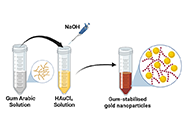 Gum Arabic-assisted green synthesis of gold nanoparticles as fluorescence modulator for potential analytical applicationsOpen AccessOriginal ArticleAim: To demonstrate a simple, eco-friendly, and cost-effective green method to synthesize gold nanoparticles (AuNPs) using the aqueous extract of gum Arabic (GA) as a reducing and stabilizing age [...] Read more.Ahmed T. Algahiny ... Fryad Z. HenariPublished: July 28, 2024 Explor BioMat-X. 2024;1:190–201
Gum Arabic-assisted green synthesis of gold nanoparticles as fluorescence modulator for potential analytical applicationsOpen AccessOriginal ArticleAim: To demonstrate a simple, eco-friendly, and cost-effective green method to synthesize gold nanoparticles (AuNPs) using the aqueous extract of gum Arabic (GA) as a reducing and stabilizing age [...] Read more.Ahmed T. Algahiny ... Fryad Z. HenariPublished: July 28, 2024 Explor BioMat-X. 2024;1:190–201
DOI: https://doi.org/10.37349/ebmx.2024.00014
This article belongs to the special issue Green Nanoparticles for Biomedical Applications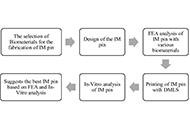 Bio-materials for intramedullary pin application in canine femur: a comparative analysisOpen AccessOriginal ArticleAim: In this study, the finite elements analysis (FEA) was performed on an intramedullary (IM) pin to be used in the canine femur. The 03 different biomaterials [17-4-precipitated hardened (PH)-s [...] Read more.Minhaz Husain ... J. P. DavimPublished: June 27, 2024 Explor BioMat-X. 2024;1:178–189
Bio-materials for intramedullary pin application in canine femur: a comparative analysisOpen AccessOriginal ArticleAim: In this study, the finite elements analysis (FEA) was performed on an intramedullary (IM) pin to be used in the canine femur. The 03 different biomaterials [17-4-precipitated hardened (PH)-s [...] Read more.Minhaz Husain ... J. P. DavimPublished: June 27, 2024 Explor BioMat-X. 2024;1:178–189
DOI: https://doi.org/10.37349/ebmx.2024.00013
This article belongs to the special issue Metal 3D Printing of Biometals for Prostheses and Implants -
